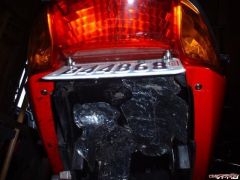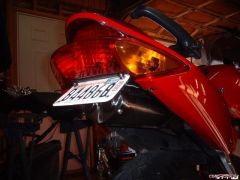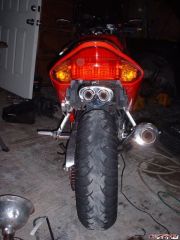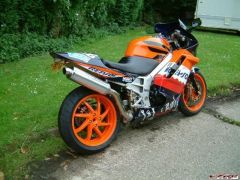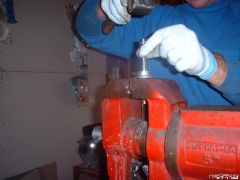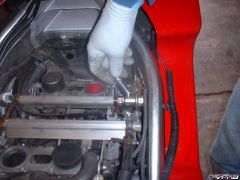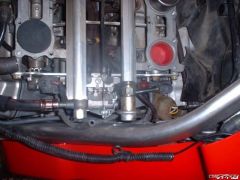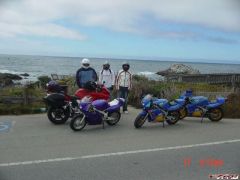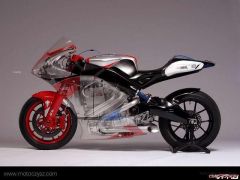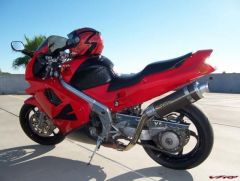-
Posts
381 -
Joined
-
Last visited
Content Type
Forums
Profiles
Gallery
Blogs
Downloads
Events
Everything posted by magellan
-
From the album: Motoczysz
-
From the album: Motoczysz
-
From the album: Motoczysz
-
-
Does anyone know if the 6th gen Motovation sliders bolt right onto a 5th gen? I can't find them listed for a 5th gen on the 2 or 3 sites I've checked.
-
Although I understand and appreciate this info, I still have to consider several possibilities. First, Honda may have been tuning for Helmholtz resonance that exists because of the existence of the airbox in the first place or the use of the snorkel, or a common and universal result of low-to-medium-speed sudden large throttle openings, or... who knows? Whatever their reasons were, we surely bugger up whatever airflow characteristics they were accounting for when they designed the flapper. Whether that really messes up driveability or power output is easily determined at the dyno (or by our sweetly tuned metric pant seats :D ). This thread:(http://www.vfrdiscussion.com/forum/index.php?showtopic=16299&hl=dyno) shows that pulling the snorkel does little to change horsepower but makes intake noises most of us like, and I'd bet that before-and-after dyno runs for de-flappering would also show very small variations. So, if it really makes little difference, do what you like. On the other hand, what if I fiddle with the airbox and get 5 more HP above 7000 rpm but lose 5 between 4-6000? Would it be worthwhile? Depends on me and what I want from the bike. If in doubt, I should just spend my time and money tuning the nut that twists the throttle or 'tuning for what I know' as Trace puts it. Since I'm a mechanic and seem to just love writing windy posts, I'll probably tweak and tune like a madman and do exhaust gas analysis at each pipe until I've got it tuned to (subjective) perfection. And that's the day I'll get broadsided by a bus... :beer:
-
Wow, I leave for a few hours and the whole thread goes ballistic! Awesome advice and thoughts from everyone. As far as fuel injected engines, 'Helmholtz resonance (http://www.phys.unsw.edu.au/~jw/Helmholtz.html) and other esoteric physics to maximise cylinder filling' do come into play, though not nearly as much as with carbureted systems (for the reasons mentioned earlier in the thread). Engineers know that big pressure pulses and areas of low pressure at the mouth of a specific throttle body or intake runner will create an imbalance in air/fuel ratios between cylinders. Generally, these imbalances are quite effectively engineered out before the product goes to market and gets all screwed up by us in our silly quest for more power. Tuning aficionados (aka 'nutcases' :beer: ) go to great lengths such as extrude-honing intake runners and polishing ports to reduce unwanted turbulence or restriction [the thermo-plastic intake plenum on Trace's Vette does a hell of a job delivering air equally, smoothly, and abundantly to the intake valves, where precisely metered fuel is injected by the ecm based on inputs from the mass airflow meter (MAFS), coolant temp sensor (CTS), intake air temperature sensor (IATS), throttle position sensor (TPS), and oxygen sensors (O2S)]. As mentioned, the VFR's EFI is primitive in comparison. I suspect Honda wanted to avoid going directly from carburetion to a system as complex and "sensor-intensive" as the Vette's while still addressing stiffer international emissions regs. So where does that leave us? We could all pull our airbox lids off and do timed runs as Trace suggests (a great start), we could make repeated trips to the dyno after every little mod ($$$), or we could weld bungs into each exhaust pipe in the header and install wideband O2 sensors from Dynojet or Innovate and really get hard facts. Doing the latter would allow me to see whether a specific cylinder is richer or leaner than its mates and would indicate whether a particular injector was less efficient than the others or airflow into a velocity stack has been hindered by my fiddling. By doing so I make myself significantly smarter about what my bike is doing than the ecm or even a Power Commander can be. I can then make mechanical changes or adjustments to the fuel map and tune my bike to the Nth degree. The problem, and it's a doozer, is that at this level of analysis, my bike will be revealed to be quite different from any of yours, so one-size-fits-all mod advice no longer works. Much depends on personal expertise and how much we individually want to spend, and unless we're each going to take a turn optimizing everything on our own bike, we have nothing better to rely on than anecdotal modification suggestions (scary) or our own instincts (as Chumly says, "I would probably not be able to know for sure if I was making overall air flow parameters better, but I would probably notice when I made them worse!"). With things like pulling off the top of an airbox, it's a good idea to be fully prepared to buy a replacement for the part we just mangled. Keep in mind too that it is certainly possible to exceed persional expertise and do permanent damage in the quest to "make a VFR into a 'Busa". Nevertheless, it's a hell of a lot of fun to try!
-
I agree. I'm not a designer either by any means but in my shop I've dealt with some bizarre air supply issues. However, in the case of removing pieces above the air filter, my instinct says the filter itself will smooth airflow enough to mask an otherwise ill-advised modification. No doubt a great deal of the VFR's airbox design has to do with meeting noise and emissions regulations, so as long as you don't care about such things, there's no doubt a fair bit of latitude with which to effectively modify the box for more flow. Still, it would be a good idea to be ready to modify the air/fuel ratio after making that much more air available over the stock setup.
-
Without doing the math, my thinking was similar, I don't think removing the whole top will do much to increase airflow beyond removing the snorkel and flapper, but who knows? It might make a small difference due to better equalization of air pressure and less turbulence above the velocity stacks (or the opposite! Who can guess without research in a wind tunnel?).
-
Sounds like a topic that needs a whole new thread, and certainly raises my eyebrows. I personally have a de-flappered and de-snorkled airbox with a K&N filter. With a filter that actually fills the available space (BMC), and no cover above it, you'd move a hell of a lot of air. The only downsides might involve areas of negative pressure above the filter and the necessity of more frequent cleaning of bugs and crap out of the filter. Intriguing idea; I may have to cut out at least the whole front portion of the airbox lid (assuring that entering air has the advantage of the positive pressure above the front valve cover). As for what we're trying to do with the fuel pressure regulator, it has nothing to do with 'creating more air draw in the combustion chamber'. It has everything to do with making sure the available air has enough fuel mixed with it to achieve a ratio providing the most power under every load. With that in mind, cutting the top off of the airbox only makes a lean bike leaner. A modified FPR just became even more important than ever for your bike. I'm sure you're now running very lean at some points in the rev range. :o
-
NVR2L8, thanks! This is exactly what we need and answers quite a few questions. For example, Turbo City must be making some internal modification to achieve fuel pressures as high as 48psi; we can rule out a simple spring preload adjustment, which is a very modest alteration in comparison. The fact that you've worked so hard with the PCIII yet had your greatest success by upping fuel pressure is also enlightening, and I wonder whether it might not be a good idea at this point to see what happens with the O2 sensors reconnected. I'd also like to know what difference it would make to synch the SV's with some offset between cylinders (ala the following...). To quote tok tokkie on the VTEC starter valve thread, "The Brits - on their website - have made a truely HUGE issue about how the starter valves should NOT be syched all the same. They believe there was a miss-print in the vtec service manual which omitted the 20mm difference there should be between the 4 starters. The 5th gen has the 20mm difference & those specs were left out in the vtec service manual - the Brits show the two pages in the respective service manuals & it does look as if the text has been left out of the vtec manual compared to the 5th gen. They believe that svynchronising them all together gives the snatch throttle at small openings & that bringing in the starters in sequence makes the throttle much smoother. Basically you start with a V-twin then 10mm later have a V-three & then another 10mm later a v-four."
-
Can we get some feedback here from guys with a PCIII installed who've done work with a dyno? Would you prefer to mess with injector pulse-width less because more pressure is available across the board? Would increased fuel pressure make an idealized PCIII map less of a departure from stock mapping? Knowing this would indicate whether a PCIII is a wise use of money after installation of a modified FPR. Obviously the PCIII would be great to have no matter what, but some of us just want bikes that run great with the least amount of fiddling possible (not me though! :D )
-
Thanks guys... I'd love to say I've been racking up miles so I can give more of a long-term report, but I'm in Hawaii for 9 days. Pity me... 9 days of surfing, luaus, and hula girls and all I can think about is where to rent a bike to tour the island! :P I have to say though, the ride I took last Sunday was confidence-inspiring. I can't imagine any long-term concerns that would not also have to be shared by Turbo City (I'm guessing the higher-pressure FPR they're testing runs substantially above the 40.5psi I'm getting). Enzed, the shift kit was a "maintenance necessity, the PCII is a "factory recall recommendation" to correct "dangerous" fuel-delivery issues, and modding the FPR is... mmmm, "an accident that happened when my crappy metric prybar slipped". It's all about terminology... :beer: Trace, I don't mean to make too much of the benefits here (it's not like it adds heaps of HP), but I do think it does a really good job (to quote you), 'helping the flatness/notchiness at low-to-mid revs on 5th Gens... A little fuel pressure gives some tune-ability that otherwise might not be there.' And I certainly don't see why it won't work equally well on 6th gens but I'm very interested in knowing what the TCFPRs are putting out in streetable trim before I suggest that DIYers shoot for a specific pressure. Fallzboater (or anyone else with a Turbo City FPR on a 6th gen), have you checked fuel pressure yet? Please let us know what you have. Thanks all.
-
Oh, well you'll definitely have to go get a whole new set then... :beer: As far as the spring seat goes, you'll find that it has a small cup in the center (imagine this from the inside of the FPR - it's like a Lego bump that the spring sits around and atop so it doesn't move around), into which you can center the ball bearing. With the pry bar pushing on the bearing opposite the cup, you'll apply even pressure to the edge of the cup as you push it inward. It's easier than it sounds once you see what the FPR looks like; I imagine finding a big ball bearing will be the hardest part of the job! PS: Yeah, I was just using the socket as a drift. The bearing will center even better.
-
There's not enough clearance between the frame and the butt end (spring seat) of the FPR for a socket; thus the ball bearing idea... As for your thoughts and concerns, seadooloo, let me just say that I often write things satirically to get a laugh. Sorry if that doesn't translate well in forum posts. I too think Turbo City Tom is doing a hell of a job and deserves every dime he charges for his FPRs. Guys like him prove that ingenuity is not confined to manufacturer engineering staffs, and I was definitely kidding about the hate mail. Hilarious, wasn't it? :beer: As far as doing a proper job of calibration... heeeyyyyy, just what are you saying about my hammer?? It's a finely tuned instrument, my friend Besides, I really just wanted to see what could be done on a 5th gen. If I'd screwed it up there would already be a new FPR on its way in the mail - probably from Turbo City! As it stands, I'm glad I did it even though I feel the method can be improved on.
-
It's worth a try. I thought mine ran flawlessly before. It just runs, uh... more flawlessly now. :D
-
I finally took it for a shakedown run today. I wish I'd made a dyno run before the mods - the difference is significant enough that I'd like to see hard numbers. I only got an additional 4.5 psi out of the mod and am not inclined to think more would be better. Does anyone know what the 6th gen Turbo City FPRs are bumped up to? Just off idle, if I dump the clutch in first there is significantly more torque - there's simply more fuel available. At 10mph in 2nd, the bike just swallows big gulps of air through the intake and pulls away; previously it would stall. Throughout the rev range the bike pulls harder with no flat spots or surging. Freeway on-ramp acceleration was smile-inducing (seat of the pants says I've dropped a few tenths to 90mph). That being said, top-gear roll-on is where this modification makes the most obvious (to me) improvement. It feels about like 5th did at the same speed before. For me, this alone makes the mod worth doing. For 5th gens with aftermarket air filters and exhaust, this may just be the thing to do next. Especially with a PCII for fine tuning, there should always be enough fuel, allowing for shorter pulse-width at the injectors. Definitely a plus, especially at higher revs. No complaints here, except that now I want a PCII to play with. :beer:
-
Your idea is actually great, David,. I'm sure a small valve can be found that would regulate vaccum in the FPR circuit without opening the line at all to outside air - no vacuum leak. With the fuel pressure gauge in place you'd see results on the fly. As for the 10% I was shooting for, I simply aimed for the result the Porsche FPR-modification site suggested. More increase in pressure might be effective with a bigger spring (which might be what Turbo City does - who knows?), but I'll try this first. Baby steps... :thumbsup: If this works, do you think Tom from Turbo City will start sending hate mail?? Lon PS: We keep haunting the same threads. I think we're gonna have to meet up for a ride and BS about this stuff over a beer. :huh:
-
Yesterday, Zyvek asked why it wouldn't be a good idea to modify a stock VFR fuel pressure regulator yourself: http://www.vfrdiscussion.com/forum/index.p...6229&hl=diy So today I had the bike apart for its 16,000 mile service. I flushed the cooling system, brakes and clutch, changed the oil and filter (MB1 15W-40 gold cap), got rid of the PAIR system (as per: http://www.vfrdiscussion.com/forum/index.p...hl=pair+system), checked valve clearances (all perfect at 16,068 miles), checked synch on the starter valves (similar in principle to this VTEC thread: http://www.vfrdiscussion.com/forum/index.php?showtopic=7935), and cleaned and oiled the K&N. So I figured, "What the hell, I'm in this far, why not try to modify my own fuel pressure regulator (FPR)? I can always get a new one for $39 if I screw up." So I removed the velocity stacks and airbox pan (lots of hoses and coil wires - take pictures or have a shop manual handy unless you have a photographic memory), clamped the fuel return hose (on bottom of FPR - big fuel spill if you don't clamp it!) and used it to drain the tank into a gas can; removed tank and side fairings (I had other work to do, so it all had to go), pulled off the vacuum hose to the FPR, and cracked it loose from the fuel rail. Intake Plumbing and FPR Here's where I ran into a headache, and I can't advise you to do what I did (I've since had a better idea. See below). The fuel return nipple on the FPR spins around and hits the choke adjuster-screw stop plate, so instead of removing the fuel rail I just grabbed a socket and very gently bent the nipple until the FPR came free. :goofy: Bending the Fuel Return Nipple Once I had it out, I took it to the vise and gave it a gentle tap. I was surprised how little force was required. One tap pushed the FPR spring seat inward about 2mm, so I called it good at that. Highly Scientific Modification Installing the FPR required that I re-straighten the fuel return nipple, and you better believe I was scared I'd crack or break it, but this cheesy metal bends nicely so mine was okay. The better idea? Leaving the tank attached, remove the airbox and plug open vacuum lines. Without removing the FPR, grab a paint stir stick, hold a ball bearing (approx 3/8"-1/2". From a hobby shop??) on an extension magnet and position it between the frame and the spring seat recess on the FPR. Using the stir stick to protect the frame, insert a pry bar between the ball bearing and stir stick and gently pry the seat inward about 2 mm. Better idea yet? Start the engine with a fuel pressure gauge attached, get a baseline reading, then pry the spring seat in and watch the fuel pressure until you have it just right. Wish I'd thought of it before I did what I did. I went ahead and buttoned everything up and put a "T" in my fuel feed line permanently for easy fuel pressure readings later. I now have 40.5 psi fuel pressure (up from 36 psi stock. Shoot for about a 3.6-5 psi increase with this mod, or approx 10% over stock pressure), and the bike starts and runs beautifully. Tomorrow I'll put the fairings back on, burp the cooling system again, check fluids and go for a ride. I have the aforementioned K&N air filter and a Satantune, so I've likely been running lean with only my ecm running the fuel delivery show. With this mod I expect to see a slight (hopefully noticeable!) increase in power (especially just off idle) without significant loss of fuel economy. I'll post results. Need sleeeeeeeep now :huh:
-
From the album: Motoczysz
-
From the album: Motoczysz
-
From the album: Motoczysz
-
-

That Twin Bros really finishes out the chrome side...
magellan commented on a gallery image in Member's Gallery


